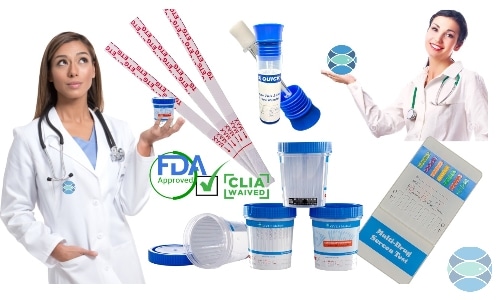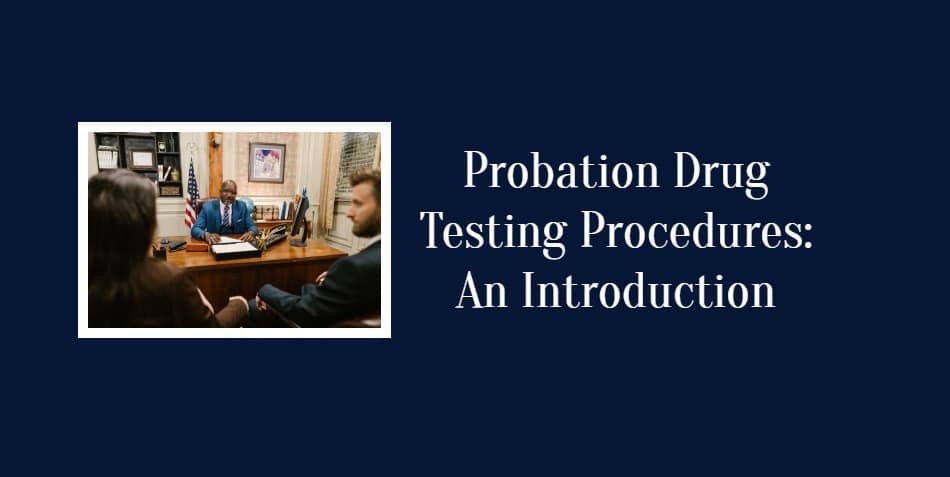Purchase Drug Testing Supplies here At Lowest Prices Guaranteed
One can call probation a gift. It means the offender does not go to jail, although they’re still penalized or punished for their wrongdoing. Someone who’s on probation has to strictly follow certain rules or conditions like probation drug testing so they can continue to stay out of jail. These conditions may include sticking to a curfew, getting and keeping employment, and not taking alcohol or drugs.
If there is any violation of these conditions, the offender can lose their freedom, go to jail, or pay a hefty fine.
Substance abuse is often linked to criminal activities, and this is why a person on probation is often required to undergo probation drug testing. Testing takes place several times during probation, and they’re all done at random. Not knowing when they’ll tested can motivate a person on probation to avoid taking drugs and alcohol altogether.
Probation drug testing methods
Urine testing is the most commonly used probation drug testing method. It has the lowest cost among other drug tests, and urine sample collection is fast and non-intrusive. Urine is also highly concentrated and retains traces of substances and their metabolites anywhere from one to seven days.
Probation drug testing may also include hair follicle testing. As urine has a short substance retention period, it cannot show if a person is a habitual user of certain drugs. On the other hand, hair follicles can retain traces of drugs for up to nine months and are therefore good indicators of prolonged and habitual drug use. In most cases, hair follicle testing is done only when a person does not pass a urine test.
In contrast to urine, however, hair follicles cannot detect recent drug use. It takes around 5 to 7 days before drug substances can accurately tested.
Probation drug testing can include anywhere from 5 to 12 substances. As the most abused drugs, the following substances are also the most tested:
- Marijuana
- Cocaine
- PCP
- Opiates
- Amphetamines
Urine drug testing kits typically include five panels that test for these drugs in a single sample. One can use an additional panel or more, as needed, to test for more substances, such as barbiturates, methadone, and benzodiazepines.

Buy more Products at the Lowest Prices with Guaranteed Fast Shipping
Step-by-step probation drug testing procedure
1. Notification
- The probationer is notified about the drug testing requirement, either during an office meeting, in written form, or as part of the probation terms.
- The individual may be scheduled for a random or scheduled drug test, depending on the probation rules.
2. Arrival at Testing Facility
- The probationer must report to a designated testing facility or probation office.
- Some jurisdictions may use on-site testing at the probation office, while others may send the probationer to a certified lab or clinic.
3. Identification
- The probationer is asked to provide valid identification to confirm their identity.
- In some cases, the probation officer may verify the probationer’s identity by checking their probation records.
4. Informed Consent
- The probationer signs a consent form agreeing to the drug test.
- This form outlines the type of test being administered, procedures, and the consequences of tampering with or refusing the test.
5. Collection of Sample
- Urine Test: The most common method. The probationer is asked to provide a urine sample in a private restroom or testing stall. In some cases, direct observation may be required to prevent tampering.
- Saliva Test: Less invasive, probationers may be asked to provide a saliva sample using a swab.
- Hair Test: In some cases, a hair sample may be collected to test for long-term drug use (usually for tests conducted less frequently or as a follow-up).
- Blood or Sweat Tests: These are more invasive and are used less frequently, but they may be required in certain circumstances.
6. Sample Handling and Chain of Custody
- The sample is sealed in a tamper-evident container with the probationer’s identification information to ensure the sample’s integrity.
- The chain of custody form records each person who handles the sample from collection to the final testing process.
7. Testing
- The sample is either tested on-site (for rapid results) or sent to a certified laboratory for analysis.
- The test will typically screen for illegal drugs such as marijuana, cocaine, opiates, methamphetamine, and alcohol (depending on the terms of probation).
- A screening test (such as an immunoassay) is performed first, followed by a confirmation test (like Gas Chromatography-Mass Spectrometry, or GC-MS) to verify positive results.
8. Results Reporting
- Negative Result: If the test is negative, the probation officer is informed, and no further action is taken.
- Positive Result: If the test is positive, a confirmation test is conducted. If confirmed, the probation officer is notified of the result.
- The probation officer may discuss the results with the probationer and take further action, including counseling, treatment programs, or adjustments to the probation conditions.
9. Consequences for Positive Results
- If the probationer tests positive for drugs, the probation officer may:
- Issue a warning or reprimand.
- Require the probationer to attend a drug treatment program.
- Increase the frequency of drug testing.
- Modify or tighten probation conditions.
- In severe cases, a violation of probation may lead to a court hearing, where the judge may impose additional penalties, including a possible jail sentence.
10. Follow-up
- In some cases, follow-up testing is scheduled at regular intervals to ensure ongoing compliance.
- Additional assessments or monitoring may be required based on the probationer’s needs or behavior.
In most cases today, probation drug testing uses urine drug testing cups that can display the results in just around five minutes.
- The person being tested is asked to remove their outer garments to ensure they’re not carrying anything that could used to tamper with the results.
- They will then asked to turn their pockets out to show they’re empty.
- The subject washes their hands to remove any adulterant that can affect the results.
- The drug test administrator provides the person with a drug testing cup.
- As much as possible, a person of the same sex should stay in the vicinity of the person tested to ensure no violation committed.
- The person tested fills the cup with 30 mL of urine.
- The drug administrator must tell the person not to flush the toilet.
- The drug test administrator inspects the bathroom to search for materials that may have used to tamper with the results.
- The drug test administrator checks the color of the urine, which must be light yellow. If the color a very light yellow or if the sample is clear. That could indicate the sample diluted or has substituted.
- The drug test administrator puts the lid back on the urine drug testing cup and checks the urine temperature. It should be within 93 degrees to 98 degrees Fahrenheit.
- If the temperature does not fall within this range, a new sample must collected.
- When everything is in order, the cup will reveal the results in about five minutes.
In giving the test, the drug test administrator must ensure the instructions that come with the urine drug testing cup strictly followed. These instructions may vary from one manufacturer to another. So they must closely reviewed before the test given.
The results of probation drug testing can greatly affect a person’s life, so it has to done accurately and within legal guidelines. For reliable results, only CLIA-waived FDA approved drug testing cups must used. Call us today or get in touch here to learn more.
To Purchase Individual Drug Tests, CLICK HERE
FAQs
1. What is probation drug testing and why is it required?
Probation drug testing is a procedure used to monitor individuals on probation to ensure they are complying with their probation conditions. Since substance abuse is often linked to criminal activities, drug testing helps authorities confirm that individuals are not using drugs or alcohol while under probation. Violating these conditions can result in severe penalties, including jail time.
2. What types of drug tests are commonly used for probation?
The most common drug test used for probation is urine testing, as it is affordable and provides fast results. In some cases, hair follicle testing is used to detect long-term drug use, as hair can retain traces of drugs for up to nine months. Other methods may include saliva, blood, or sweat tests, depending on the circumstances.
3. What substances are typically tested in probation drug screenings?
Probation drug tests usually screen for substances such as marijuana, cocaine, PCP, opiates, and amphetamines. Additional substances like barbiturates, methadone, and benzodiazepines may also be tested, depending on the specific conditions of the probation.
4. What happens if a person tests positive for drugs during probation?
If a probationer tests positive for drugs, they may face various consequences, including a warning, enrollment in a drug treatment program, or increased drug testing. In severe cases, a probation violation may lead to a court hearing, where additional penalties such as jail time may be imposed.
5. How is a probation drug test conducted?
The procedure for a probation drug test involves several steps: the probationer must provide a urine sample, which is then inspected for signs of tampering (such as the correct color and temperature). The sample is then tested for drugs, and results are typically available within minutes. Proper chain-of-custody procedures are followed to maintain the integrity of the test.
